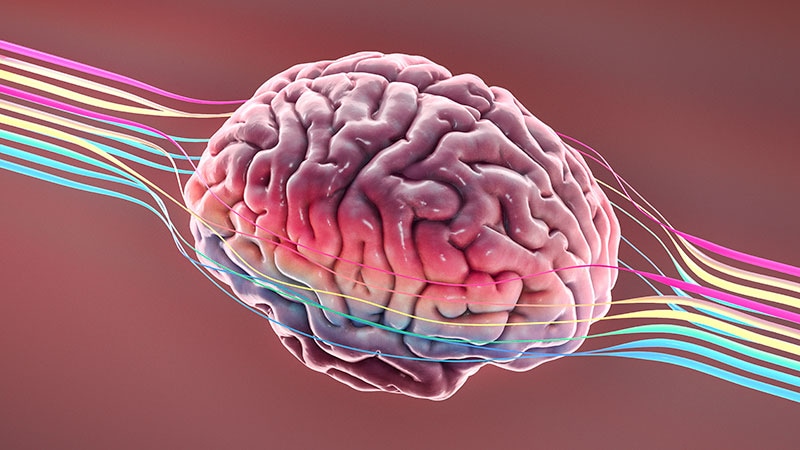A study recently published in Nature has identified a key factor in the age-related breakdown of the blood-brain barrier (BBB) and has demonstrated that this damage may be reversible, potentially paving the way for new therapeutic strategies for neurodegenerative and cerebrovascular diseases, such as Alzheimer’s disease, Parkinson’s disease, and stroke.
The study, led by Sophia M. Shi, PhD, now a principal investigator at the Rowland Institute at Harvard but a PhD student at Stanford University during the study, focuses on the endothelial glycocalyx of the brain’s vasculature, also known as the brain’s “sugar shield.” This catchy moniker is given by the fact that the glycocalyx is a sugar-rich layer lining the luminal surface of endothelial cells in the brain vasculature.
Composed of proteoglycans, glycoproteins, and glycolipids, the glycocalyx — literally meaning “sugar coat” — is the first point of contact between the blood and the vasculature of the entire body, assisting in cell adhesion, providing protection, and helping control the movement of fluids and molecules between the bloodstream and surrounding tissues.
It also plays a critical role in maintaining the integrity of BBB.
“This blood-brain barrier or vascular dysfunction is a really common hallmark in aging but also a lot of age-related diseases like Alzheimer’s disease, Parkinson’s disease, stroke,” Shi said. “We have these early changes in the vasculature that we can see.”
The research team demonstrated how a class of proteins of the glycocalyx known as mucin-domain glycoproteins are crucial for the barrier’s function, and their age- and disease-related decline is linked to a “leaky” BBB. The study showed how this decline can lead to brain hemorrhaging in mice.

“There’s a lot of proteins from the brain, like IgG [immunoglobulin G] and fibronectins, that will be toxic for the neurons if they leak. For years, people have found that during aging, one of the major problems people have been vascular damage from leaking. So people think that’s one of the reasons to look at [this leaking and vascular damage] in neuroendocrine disease,” said Lianchun Wang, MD, professor of molecular pharmacology and physiology at the Morsani School of Medicine at the University of South Florida, Tampa, Florida. Wang was not part of the study.
The Stanford study was able to restore the integrity of the glycocalyx, improving the barrier’s function, reducing leaking, and reducing neuroinflammation and cognitive deficits in the mice.
“We really wanted to see if we could ameliorate aspects of pathology and cognitive function in disease models to make it more disease relevant and potentially translational,” Shi added.
Bridging Glycobiology and the Aging Brain: A Tale of Two Labs
The study’s inception came during Shi’s PhD studies at Stanford University while she was jointly advised in the labs of Carolyn Bertozzi, PhD, a Nobel laureate and professor of chemical and systems biology at Stanford, and Tony Wyss-Coray, PhD, professor of neurology at Stanford.

“I was really interested in trying to understand small chemical modification to proteins like glycans, and I found an interest in studying brain aging. We came up with fusing these two fields: glycobiology from Carolyn Bertozzi’s lab and neurology from Tony Wyss-Coray’s lab,” said Shi.
Both Bertozzi and Wyss-Coray served as principal investigators of the study and are authors of the paper. Shi and the research team investigated a handful of older papers that had begun to investigate the endothelial glycocalyx in the brain.
They noticed the researchers who authored those papers didn’t follow up on their results — they’d stained glycocalyx sugars but didn’t examine what these sugars really did. Realizing the field was understudied, Shi saw an opportunity to characterize the structural changes in the glycocalyx in age-related diseases.
The team used a specialized staining tool — a product of Bertozzi’s expertise in mucins — derived from a bacterial enzyme (StcE) to visualize mucin-domain glycoproteins lining the brain’s blood vessels.
“[Carolyn] had made this tool that allowed us to measure mucins…a very ingenious tool,” explained Wyss-Coray. “It’s an enzyme that bacteria make to cleave off mucins in the gut so they can infect. Carolyn used this [StcE] enzyme and introduced a mutation so it’s no longer active but still binds to the mucins. That tool allowed us to visualize the mucins. We had a new tool that nobody could even imagine one could use.”
This tool revealed a strong, continuous layer of these proteins in young mice that was significantly reduced and patchier in aged mice, a change that appeared specific to the brain. They then injected an active, “cutting” version of the enzyme into young mice, which caused a significant breakdown of this entire protective glycocalyx layer.
Clearly seeing this degradation on electron micrograph images served as the study’s “eureka” moment.
“I distinctly remember getting our first electron microscopy images back, those big pictures of the blood vessels showing degradation with age, and that was really striking,” said Shi. “But we also did many orthogonal approaches to make sure it’s really robust as a finding. Flow cytometry…transcriptional analysis…all of them pointed towards the same direction.”
Restoring the Sugar Shield
BBB’s integrity relies on specialized endothelial cells with tight junctions and controlled transport systems. But the levels of two key sugar-building enzymes, C1GALT1 and B3GNT3, were significantly lower in the brain’s blood vessels of old mice than in those of young mice. This decrease in the “builder” enzymes directly correlated with the reduced amount of the final mucin “sugar coat” that was present.
Remarkably, the team successfully fixed this degeneration using adeno-associated viruses (AAVs) to overexpress these enzymes, which restored core 1 mucin-type O-glycans of the glycocalyx to the brain endothelium. This intervention not only improved the barrier’s function but also led to a reduction in neuroinflammation and cognitive deficits in the animals.
“We’re overexpressing these sugar molecules in the vasculature, which reduces leakiness, and then we showed that it reduces neuroinflammation, and then has these wonderful improvements in cognitive function,” explained Shi.
The successful reversal of BBB leakiness and its cognitive consequences in this study’s preclinical model suggests that strategies aimed at restoring the integrity of the brain’s “sugar shield” could be a potent strategy to combat the age-related breakdown of the BBB and mitigate diseases, though human trials would need to utilize other methods than viral vectors.
Where This Takes Us
While viral vector gene therapy proved effective in restoring the integrity of the glycocalyx, the exact mechanisms underlying its success require further explication.
Restoring the glycocalyx can protect the brain by limiting the influx of neurotoxic circulatory factors like albumin and fibrinogen. However, the enzymes used in the therapy influence a wide range of proteins and glycan structures. A deeper understanding of all the molecular pathways affected may be warranted to fully grasp the processes of brain aging and rejuvenation.
“We do want to work on better understanding this pathway, to see where in the pathway we should really be targeting and see if there are small molecules that would be more therapeutically practical,” said Shi.
Added Wyss-Coray, “I think there’s much more research that could be done. Do [mucins] have something to do with preventing pathogens from getting into the brain, more so than into another organ, once they make it into circulation? Do we have microorganisms that can enter the brain more easily? Another direction is to go find out where these sugars stick to.”
The hope is this underappreciated class of mucin proteins can one day soon serve as a powerful new therapeutic target, opening a new frontier in the quest to combat age-related cognitive decline by focusing on rebuilding the brain’s own protective shield.
“I think this is fantastic in the field,” said Wang. “It really is a very fundamental study that shows how this mucin-type O-glycosylation in the vasculature is functionally very important….I think the [AVV therapy] is really important. It’s possible [translational therapy on humans] can move quickly because AAV for the gene therapies are relatively common.”
